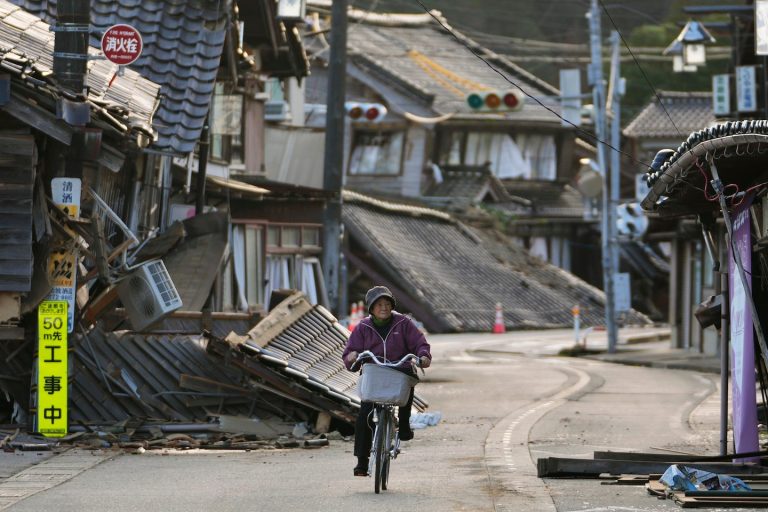Japan regularly makes international headlines due to earthquake-related damage, most notably the March 2011 triple disaster of a 9.0 magnitude earthquake, tsunami, and nuclear meltdown that led to the worst nuclear disaster since Chernobyl in 1986.
So we asked the experts: What makes Japan so vulnerable to earthquakes?
Mosaic of tectonic plates
Earthquakes occur when two tectonic plates collide and slide under each other, releasing a sudden wave of energy.
Japan sits on top of four major tectonic plates, making it one of the places in the world most likely to experience tectonic activity.
“The more plates you have, and more importantly, the more plate boundaries that a country like Japan abuts or crosses, the more interacting those plates are on which earthquakes occur,” said Robert Butler, professor emeritus of geophysics at the university. Portland and the University of Arizona. “So more plate boundaries means more earthquakes.”
Japan and the surrounding region account for 18 percent of the world's earthquakes due to active tectonics, said Seiko Kita, a seismologist at the International Institute of Seismology and Earthquake Engineering in Ibaraki, Japan.
Japan and the Ring of Fire
Every year, Japan experiences about 1,500 earthquakes that can be felt. In fact, some type of seismic activity is recorded about once every five minutes.
It's not unusual for there to be a lot of seismic activity along the horseshoe-shaped region — often referred to as the “Ring of Fire” — along the Pacific Rim, with more than 400 active volcanoes. The region extends from the east coast of Australia to eastern Russia, down the west coast of North America and along the west coast of Chile.
This is a geologically active area where earthquakes, tsunamis and volcanoes are common. About 80% of the world's largest earthquakes and tsunamis occur in this region, according to the USGS and the International Tsunami Information Center.
Taiwan and the Philippines sit atop three major tectonic plates, and are vulnerable to seismic activity as well, said Lucy Jones, a seismologist who spent more than three decades at the USGS.
Although Japan is a larger and more populous country than Taiwan and the Philippines, more attention has been paid to Japan in part because of the belief that more people are affected by earthquakes, Jones said. She added that Japan's long history of recording and studying the impact of earthquakes and tsunamis, in addition to its extensive preparations to confront disasters, has fueled this perception.
“The truth is that the Philippines and Taiwan have the same number [earthquakes] “Like Japan, but I think part of the perception is because Japan has developed the technology to deal with it,” Jones said.
The site of the New Year's earthquake and its aftershocks, on the west coast of central Japan, is near an area that has also seen several large inland quakes, experts say.
It was also on the side of the Sea of Japan, or East Sea. This is different from the majority of major earthquakes and tsunamis in Japan, which is located on the eastern side of the Pacific Ocean. However, some major earthquakes have occurred on the western side in recent decades, said Robert Geller, a seismologist and professor emeritus at the University of Tokyo.
“From time to time large earthquakes occur under the Sea of Japan. [Large earthquakes in] “1983 and 1993 were the most recent until the one that happened two days ago,” Geller said.
Junichi Nakajima, a professor in the Department of Earth and Planetary Sciences at the Tokyo Institute of Technology, said there are signs of fluids rising from deep within the Earth at the epicenter of the quake, which may be the reason behind the rupture of the January 1 quake.
The death toll from the New Year's earthquake that struck Ishikawa Prefecture has surpassed 62, with more than 100 buildings and about 1,000 homes destroyed.
Japan measures earthquakes by how much the ground shakes, not how hard it shakes. The January 1 earthquake measured 7 on the Japanese intensity scale, the highest.
Compare that to a century ago, when the Great Kanto Earthquake — a magnitude equivalent to a 7 or above a 6 on the modern scale — struck Tokyo, killing or missing more than 105,000 people and destroying about 80,000 homes. That earthquake led to the establishment of modern building codes that include earthquake risks.
With each major earthquake, the country reviews the damage and updates its building codes, with the last major update in 1981 introducing new standards for earthquake-resistant buildings following a major earthquake in 1978.
Nobuhito Mori, deputy director of the Disaster Prevention Department, said that in remote and less urbanized parts of Japan, such as the Noto Peninsula, where the earthquake struck on January 1, there are still many buildings vulnerable to damage and collapse because they were built before 1981. Research Institute of Kyoto University, Japan.
After the 1995 Kobe earthquake, the Japanese government made changes to its disaster response that allowed it to collect information within five minutes of the quake, said Geller of the University of Tokyo, and allowed for the rapid deployment of disaster relief personnel.
Julia Myo Enoma contributed to this report.

